The best peach varieties for the Moscow region
It is difficult to find a summer resident who would not dream of growing sweet and juicy peaches on his plot. And if problems arise with this in the northern regions - frosts and an unpredictable climate are to blame, then gardeners from the Moscow region boldly plant peach trees on their plots. Caring for them is not much different from caring for other fruit trees. The main thing is to pay attention to the choice of variety and follow the growing rules.
Is it possible to grow a peach in the Moscow region?
The plant must have strong immunity and be resistant to diseases and pests.. Gardeners are required to pay a lot of attention to peaches - caring for trees, weeding, and fertilizing the soil. Only if all these conditions are met will it be possible to harvest a tasty and beautiful harvest.
The Moscow region is characterized as an area with dense and nutritious soils, moderate cold. Frosts rarely occur there, but they are possible at times. Summer in the Moscow region is warm and long, with moderate humidity.
The best peach varieties for the Moscow region
Before planting, it is recommended to study information about different varieties., ask your neighbor-gardener about the harvest he harvested last year. Next, we will study the best peach varieties for the Moscow region.
Self-fertile
The yield of self-fertile varieties does not depend on the weather - trees are capable of self-pollinating at any time.Self-fertile plants do not require cross-pollination, which is rare among fruit crops and is a great advantage.
Kyiv early
The main advantage of the variety is its rapid adaptation to any natural conditions.. Kiev early quickly takes root in the Moscow region and does not cause gardeners any trouble or difficulty. The height of the tree is about 3 m, the crown is semicircular and compact.
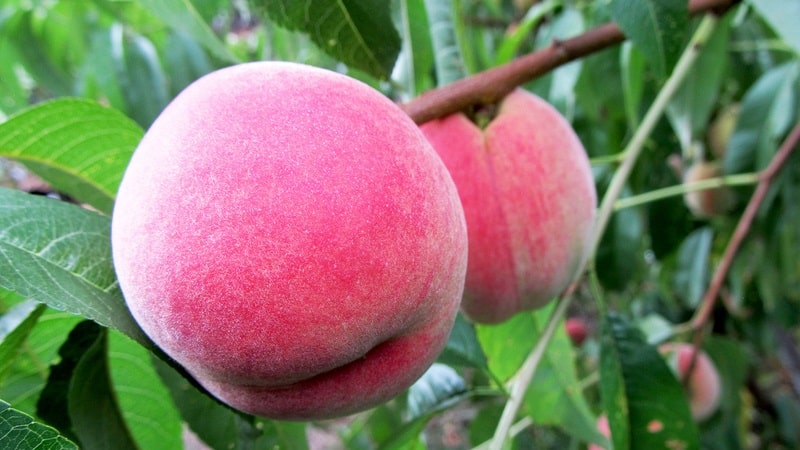
The peach itself is spherical, average weight - 80 g. The skin is thin, light yellow with pink tints. The pulp is juicy and tender, the taste of the variety is rated a solid “five”. Kiev early is grown not only by amateur gardeners, but also by large farmers.
Early champion
The trees produce large fruits - the weight of one reaches 150 g. The color of peaches is soft yellow, with a blush. The peel is dense, with fine fluff. The taste is excellent - the flesh is fleshy, with a rich aroma.
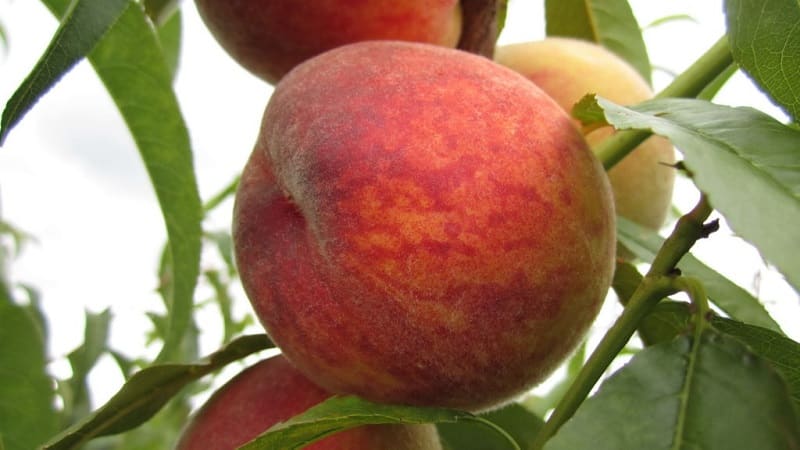
Fruits contain a lot of sugars and acidsTherefore, the harvest is used to prepare various dishes. The trees are tall, with a spreading and fluffy crown. The early champion bears fruit regularly - gardeners harvest up to 60 kg of peaches from one plant.
Greensboro
The tree is low-growing, the crown is dense and wide-oval.. The fruits are round, the average weight of one peach is 100 g. The skin has fluff and is easily separated from the pulp. The color of the fruit is pink, the flesh is greenish-cream.
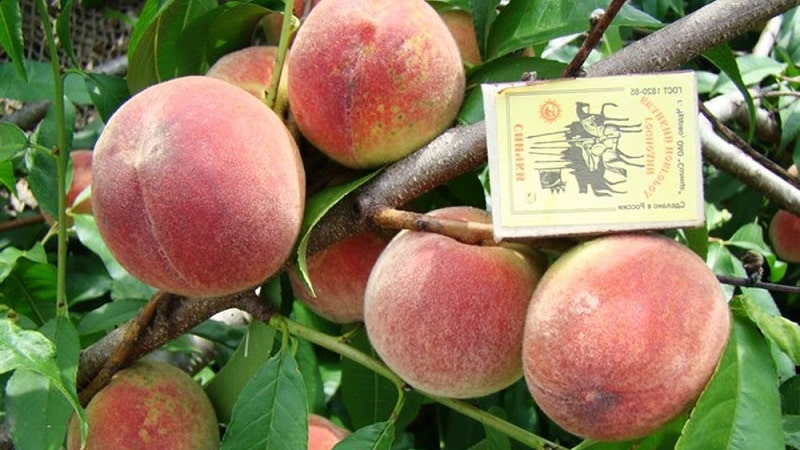
Peach is distinguished by its sugar content and rich sweet taste.. The stone is medium in size and does not separate from the pulp. The Greensboro variety has a universal purpose - peaches are eaten fresh and used in cooking.
Winter-hardy
Winter-hardy varieties can withstand sudden weather changes and cold snaps without consequences. - frosts, strong winds, heavy rains.Such peaches are characterized by stable yield.
Carnival
Medium-sized tree, pyramidal crown. The fruits are medium in size, weighing about 130 g per one. The peel is yellow with red blurry spots, with velvety pubescence. The pulp is medium hard, fibrous, sweet and juicy. The stone is ovoid and does not separate from the pulp.
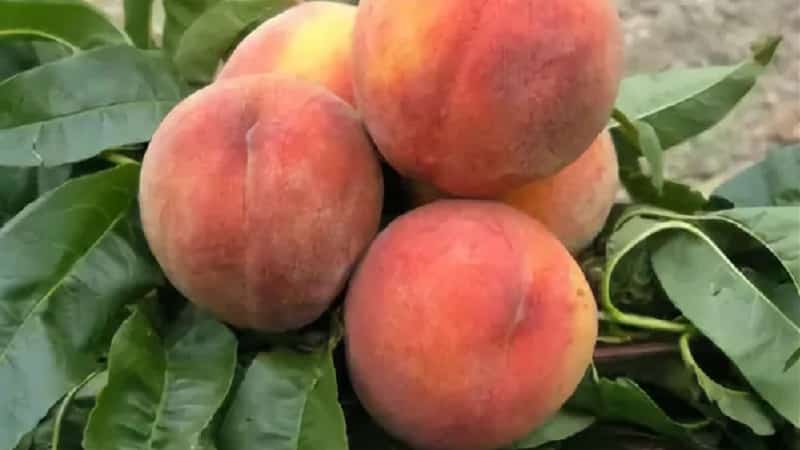
Carnival peach shows resistance to major crop diseases. The fruits are suitable for transportation and long-term storage.
Pontic
Mid-early variety for universal use. The average weight of the fruit is 110 g, the color is yellow, the peel is velvety. The pulp is tender and melting, with a sweet taste. Pontic is slightly susceptible to disease, is frost-resistant and unpretentious in cultivation.
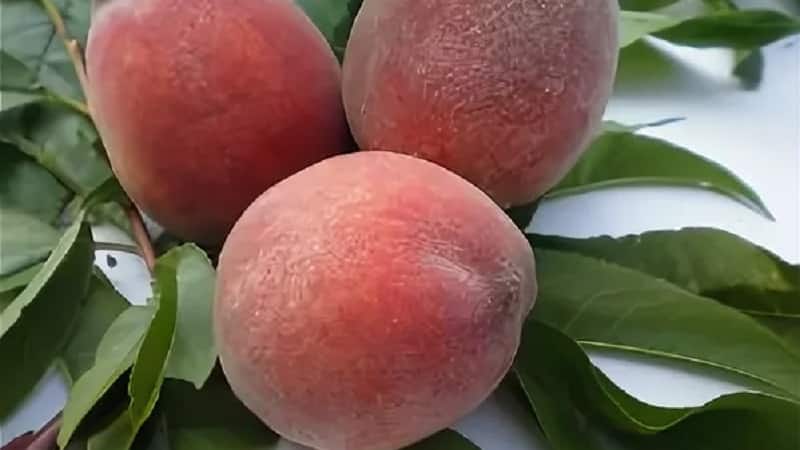
Golden Moscow
The variety is resistant to frost, heat, drought, and is slightly affected by diseases.. The tree is tall with a dense spherical crown. The average weight of the fruit is 180 g, the seeds are large and oval, easily separated from the pulp. The taste is sweet and sour, the pulp contains 11% sugars. The color of the fruit is yellow, with rare blurry spots of red.
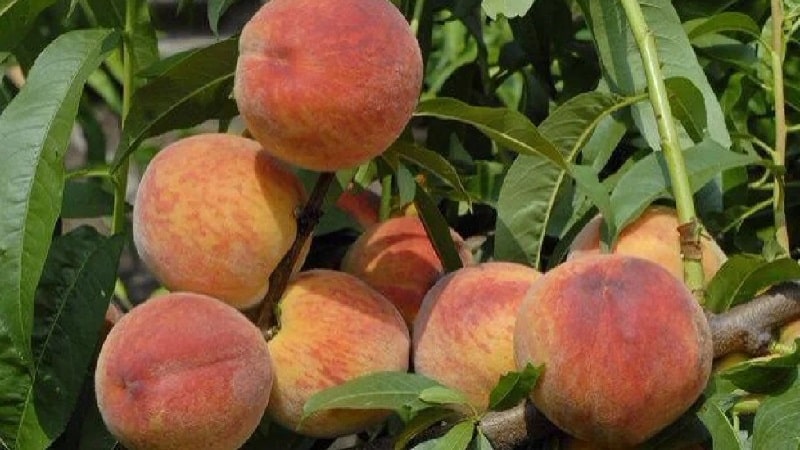
Variety Golden Moscow unpretentious in cultivation, bears fruit consistently. About 50 kg of delicious fruits are collected from one tree.
Interesting! How are peaches different from nectarines? The skin of a peach is fleecy or velvety, while that of a nectarine is smooth and glossy. The peach is tender to the touch, the nectarine is harder and more elastic. For long-term storage, it is recommended to grow nectarines; peaches are more suitable for fresh consumption or for immediate processing.
Early
Early varieties ripen by early or mid-summer. To obtain a rich harvest, it is recommended to plant them on fertile and loose soils so that the roots receive all the nutrients necessary for development.
Fluffy early
The tree is large, the crown grows quickly. The fruits are medium-sized, not one-dimensional. The average weight of a peach is about 110 g, the color is greenish-cream, with red and pink stripes. The pulp is juicy and fibrous, the taste is sweet and sour with bitterness.
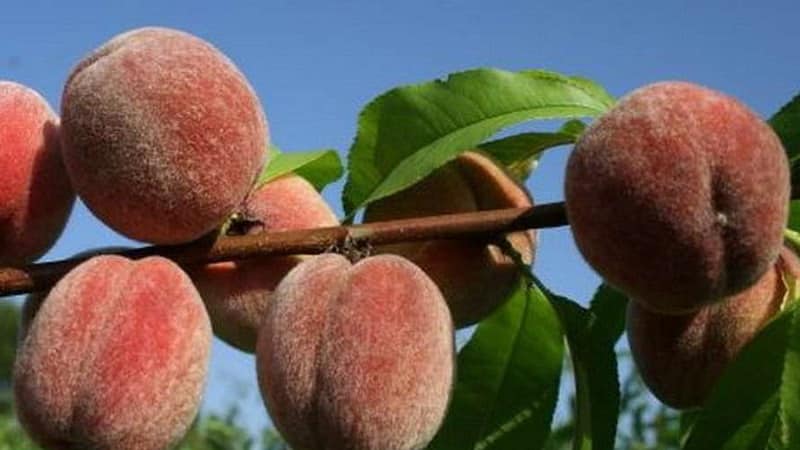
The stone is oval with pointed tips and does not separate from the pulp. Fluffy early is suitable for long-term storage and transportation — retains its commercial appearance and taste for a long time. Weakly susceptible to fungal and viral diseases.
Anniversary early
Table peach varieties are planted not only in the Moscow region, but also throughout central Russia. The columnar plant quickly adapts to weather conditions and is unpretentious in care. A medium-sized tree with powerful branches.
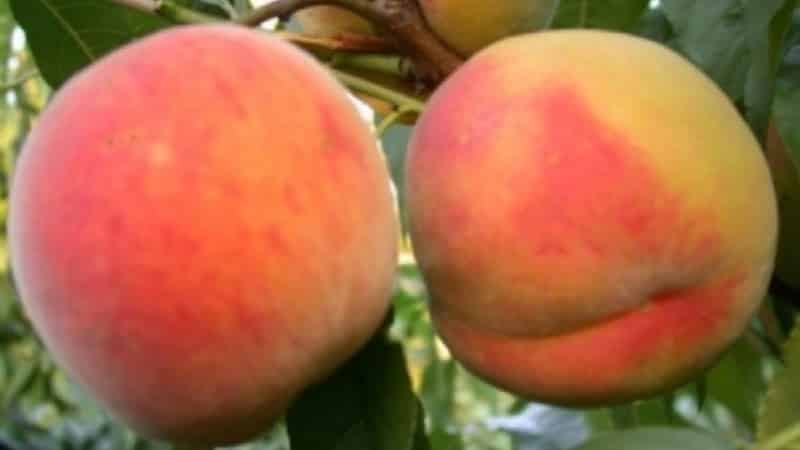
The peach is yellow in color, with light burgundy streaks and spots on the skin.. The surface of the fruit is fluffy. Peach weight is about 120 g, the flesh is bright yellow, the taste is sweet and sour. The stone is in grooves and does not separate from the pulp. Jubilee early is valued for its harmonious taste - the harvest is used for making preserves, jam, compote and other preparations for the winter.
Smart Nikitinsky
The tree is medium-sized, the crown is semi-spreading. The main color of the fruit is juicy yellow; there are red spots on the peel. The weight of a peach is about 120 g, some specimens reach 150 g. The pulp is medium coarse, fibrous, with a bright peach aroma. The taste is excellent, the peach is suitable for fresh consumption or for thermal processing.
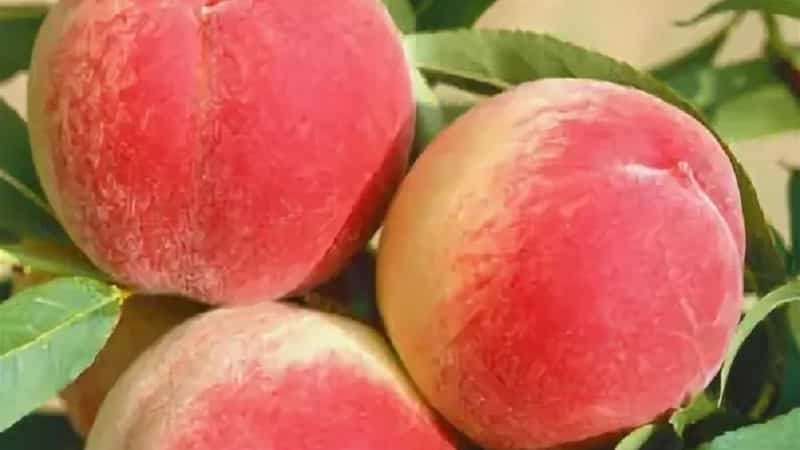
Smart Nikitinsky resistant to heat and drought, tolerates long-term lack of watering without harm to the crop. The yield is stable, about 30 kg per tree.
Mid-season
Mid-ripening peaches ripen by August — most varieties are distinguished by extended fruiting, juicy and fleshy pulp.
Myra
The mid-early variety ripens by the end of July or beginning of August. The fruits are round, yellow in color with a delicate blush. The taste is sweet and juicy, with a slight sourness. The mass of a peach is about 100 g, the peel is dense.
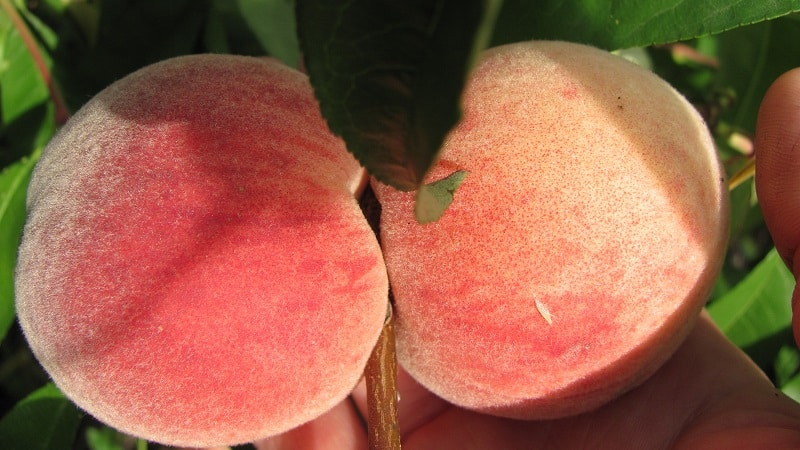
The Mayra variety peach is grown for personal consumption and for sale - Thanks to the thick peel, the fruits retain their presentation and vitamin composition for a long time.
Expectation
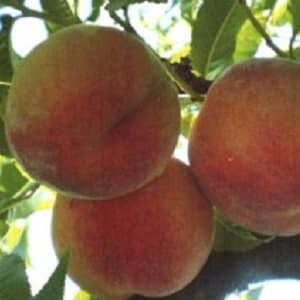 Large tree with medium crown. The fruits are bright yellow, some have red dots. The skin is soft and velvety. The pulp is yellow, medium coarse, a lot of fibers. The taste of the fruit is sweet, with a slight sourness. Perfectly refreshes in summer and hot weather.
Large tree with medium crown. The fruits are bright yellow, some have red dots. The skin is soft and velvety. The pulp is yellow, medium coarse, a lot of fibers. The taste of the fruit is sweet, with a slight sourness. Perfectly refreshes in summer and hot weather.
Peach weight is about 130 g, yield per tree is 40 kg per summer. To obtain a stable harvest, it is recommended to take preventive measures against protection and pests - spray the plants with a solution of copper sulfate and apply mineral fertilizers.
Cornelian
The universal variety has won the attention of many gardeners. — it is valued for its ease of care, taste, and attractive appearance. The tree is medium-sized, the crown is dense.
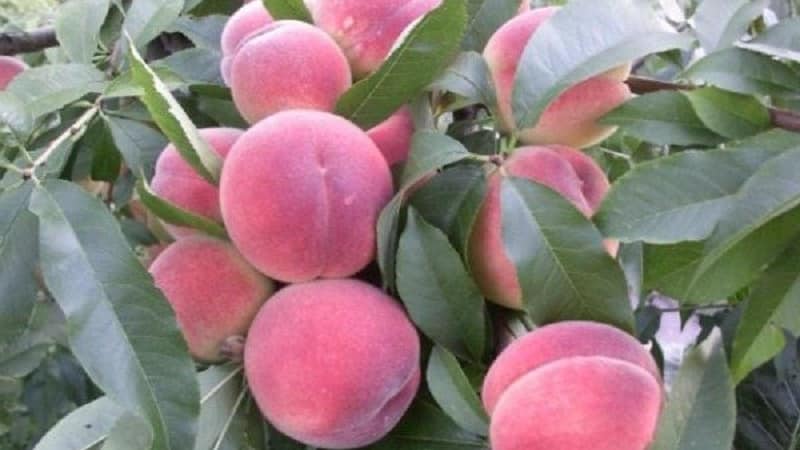
The fruits are round, peach weight is about 120 g. The color is yellow with a red “blush”, occupying up to 50% of the surface of the fruit. The stone is oval-shaped, with grooves, and does not separate from the pulp. The taste is sweet and sour, pleasant. Carnelian peach is ideal for whole-fruit canning.
Interesting! The fig peach is popular among gardeners.It got its name due to its flattened flat shape. Many people mistakenly believe that this fruit was the result of crossing a fig and a peach. However, this is just a variety of the common peach.
Growing peach in the Moscow region
Growing a peach on the plot is more difficult than cucumbers or tomatoes, traditional for the Russian climate.. However, if you follow the basic rules of agricultural technology, every gardener can get appetizing and juicy fruits.
Planting a seedling
Peaches are planted in spring or in autumn. For the Moscow region, the second option is suitable, since winter begins in accordance with the calendar, and not in October (which is typical for the northern regions of the country). In the autumn-winter period, the peach tree sleeps and is not disturbed by insects and rodents. The roots develop under dense soil, and the plant’s immunity is strengthened.
It is recommended to choose two-year-old seedlings for planting.. They should look strong and healthy, without wrinkled bark or wilted leaves. Particular attention is paid to the root system - it should be fibrous. A few days before planting, the seedling is placed in a bucket of warm water, a growth stimulator is added, for example, “Zircon”, “Epin-Extra”.
Peach is a sun-loving plant, so a warm and spacious place on the site is allocated for it. The planting site should not be shaded by other trees or garden buildings. An excellent option is a hilly area next to a hedge.
Attention! A place where nightshade crops such as potatoes, eggplant, and peppers previously grew is not suitable for planting peach. It is not recommended to plant it next to other fruit trees - apples, pears, plums.
Care after landing
They begin to care for the peach tree in April. - gardeners carry out the first treatment with Bordeaux mixture against aphids and other insects. After a month, excess ovaries are removed, leaving 8-10 cm between future fruits. The soil near the tree trunk is loosened and cleared of weeds. It is necessary to regularly maintain cleanliness between trees and beds - otherwise there is a high risk of developing diseases.
Gardeners It is recommended to carry out 2-3 root feedings before harvesting. Potassium mixture, Zdravy or Magic Watering Can plant complex are used as fertilizers. Apply fertilizers after watering - this way more nutrients will reach the roots. In the spring, peach trees are sprayed with a urea solution (0.5 kg per 10 liters of water) at the rate of 2-2.5 liters of solution per 10 square meters. m.
Late-ripening varieties are watered six times per season, early-ripening varieties - three times.. One tree requires about 10-15 liters of water. The first watering occurs at the beginning of summer, the last - about 20 days before harvest. Water in the morning or evening to protect plants from sunburn.
Attention! An important stage in growing peaches is protection from diseases and insects. Common and effective preventive measures are spraying with a solution of Bordeaux mixture, potassium permanganate or copper sulfate. They provide protection against powdery mildew, aphids, and slugs.
How to grow from seed
Planting and caring for peach pits is similar to traditional growing methods.. First, prepare the pit - remove it from a peach variety suitable for the Moscow region. Dry it and put it in a dry and dark place until autumn. Two days before planting, it is soaked in water and broken along the seam, after which the seed is removed from the inside.
In the garden, prepare a planting site and dig a hole 10 cm deep. Place a seed inside, sprinkle with soil, water and mulch. After winter, they begin standard care - water and fertilize. The plant should grow to form a trunk as thick as a pencil.
In the second year a tree is formed and clear the crown of thick branches. The peach tree bears fruit in the third or fourth year.
Interesting things on the site:
When does a peach ripen in the Moscow region?
Most varieties ripen in the second half of July — the fruiting period lasts throughout July and August. Super early varieties ripen already in June - but bear fruit in only 2-3 weeks. The ripeness of a peach is determined by its color - the greenish tint changes to cream and yellow. The peel becomes smooth, the trees emit a pleasant sweet aroma.
Conclusion
For cultivation in the Moscow region and the Moscow region, the large-fruited Pontic, Myra, Yubileiny early, and Elegant Nikitinsky peaches are chosen. Peaches take root in nutritious and light soil; gardeners harvest the first harvest 3-4 years after planting.
Care consists of tree shaping, fertilizing and watering. The average weight of a garden peach is 100 g, the pulp is juicy and sugary, and the aroma is rich. The fruits are used for making desserts, baked goods, and winter preparations.